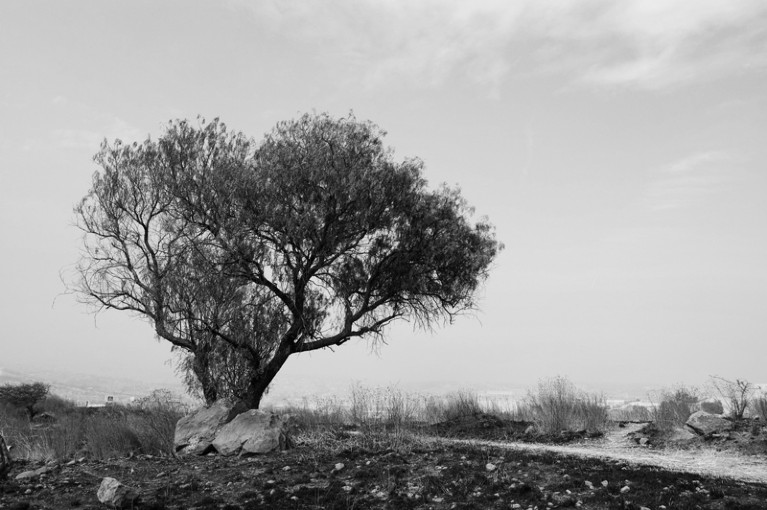
Invasive plants such as the Peruvian pepper tree (Schinus molle) could be less particular about climate than was thought.Credit: Guillermo Lopez Barrera/Alamy
Officially, Peru’s most important export is copper ore. Unofficially, its most significant contribution to nations across the Americas is probably the pepper tree. Before the iconic palm trees came to Los Angeles, the streets of southern California were known for the knotted trunks and pink berry clusters of the Peruvian pepper (Schinus molle). And after it was introduced alongside the potato to sixteenth-century Mexico, the pepper tree became so common there that many Mexicans today see it as a national symbol.
To botanists, the pepper tree is technically an invader in Mexico, and has been studied as such. Last year, for example, a study used its geographical range to analyse how scientists model the spread of such invasive plants. The authors found that the tree was doing better than expected and was managing to grow in parts of Mexico that models suggested should have an unsuitable climate. The expected climatic constraints, in other words, weren’t constraining the spread of the tree at all. The researchers put this down to human activity: people were deliberately planting and nurturing the tree and helping it to survive otherwise inhospitable conditions (J. E. Ramírez-Albores et al. PLoS ONE 11, e0156029; 2016).
The impact of human activity on plants and trees is often presented as more problematic, especially when seen through the lens of climate change. A warmer world offers a challenge to all species that have evolved to flourish in certain weather conditions, including humans. And whereas fauna such as some fish and birds can up sticks and shift with the climate — suitable habitat permitting — flora anchored to the ground faces a more enduring crisis. Or does it?
A paper published this week in Nature Ecology & Evolution challenges a common assumption about plants and trees: that if they are to move (or be moved) to a new home, they will demand a set of environmental conditions that are similar to where they originated. In fact, the study suggests that terrestrial plants are much more hardy than many conservationists believe, and that they manage to live in different climatic conditions across the globe (D. Z. Atwater et al. Nature Ecol. Evol. http://doi.org/cgx3; 2017). The scientists say that a plant’s ability to survive contrasting climates in, say, North America and Oceania, can make identical plants living in different places look like separate and distinct species. For example, the bushy Scotch broom (Cytisus scoparius) lives in much warmer and wetter conditions in North America than in Australia or its native range in Europe.
The technical term for the willingness of a plant to live in habitats of different average temperature and rainfall is called a climatic niche shift. But when is a niche not really a niche? One answer is when, as this study of some 815 species showed, between 65% and 100% of plants would put up with climate conditions on a separate continent that were thought to be beyond them. And the researchers saw similar, but smaller, intercontinental niche shifts even for species that were within their natural range. Everything in the garden might not be rosy, but roses and other plants might be able to survive in more varied gardens than was thought.
This study is unlikely to be the end of the matter. Debate about the flexibility, or otherwise, of climatic niches has swung to and fro in recent years. It’s a hot topic precisely because, as the authors of the latest study write, the results “have major consequences for applying environmental niche models to assess the risk of invasive species and for predicting species responses to climate change”.
A common prediction for how plants will respond to climate change is that it is humans who got them into this mess and so it is humans who will have to get them out of it. That’s why the idea of assisted migration of species, although often illustrated with the proposal to shift polar bears to the Antarctic, crops up more frequently in conversations about how to preserve iconic trees. Indeed, in one of the only real-world examples of assisted migration so far, campaigners have planted the seeds of the critically endangered conifer Torreya taxifolia hundreds of miles north of its Florida home.
A more flexible climatic niche presents extra options for assisted migration when it’s really needed. But that flexibility might also reduce the need for species to be moved in the first place — if they can simply adapt.
Whether they can do so is far from clear. The authors of the latest paper aren’t confident about how and why the plants can survive such different climates, although they suggest that evolutionary changes and interactions on the ground with other species could play a part. Some environmental change is too great and too rapid for species to adapt to. The palm trees in Los Angeles look to be going the way of the Peruvian pepper: as the palms die off from disease and old age, city officials say they will plant replacement species that provide more shade and need less water. The trees’ niche appeal is no longer enough.
